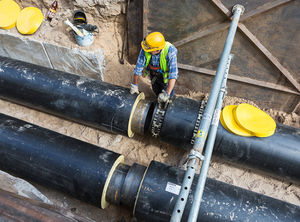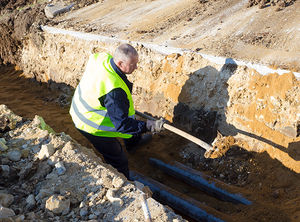 When closed-cell, thermal pipe insulation is considered for a direct-bury application, contractors need to be aware of concerns and what to avoid for a successful installation. We recommend the best practice of encasing AP ArmaFlex® pipe insulation in a protective conduit such as properly sealed PVC pipe, corrugated drainpipe, or poured concrete for long-term service, but first, let’s review the risk and reasons to take this extra step before burying insulation in the ground.
When closed-cell, thermal pipe insulation is considered for a direct-bury application, contractors need to be aware of concerns and what to avoid for a successful installation. We recommend the best practice of encasing AP ArmaFlex® pipe insulation in a protective conduit such as properly sealed PVC pipe, corrugated drainpipe, or poured concrete for long-term service, but first, let’s review the risk and reasons to take this extra step before burying insulation in the ground.
- The first reason to encase pipe insulation before burying it is the exposure to ground water (above or below the water table). This issue occurs usually from ground water infiltration penetrating through cracks or improperly sealed insulation seams, causing water to get trapped between the pipe and insulation. Long-term water penetration coupled with the presence of ground water chemicals or contaminants can reduce thermal efficiency of the insulation, damage copper or steel pipes, and cause corrosion under insulation of the pipe. Particularly there is a concern of chloride ions from brackish water or ground salts and nitrite ions from agricultural runoff or sewage.
- The second reason is to prevent insulation compression under the static load exerted from soil or ground materials like rocks or sand. This static load imposed on uncovered, buried insulation, squeezes the insulation causing a 20% reduction of the intended wall thickness resulting in a loss of thermal insulating performance. In addition, simply increasing the wall thickness of the insulation will not totally compensate for this loss in thermal performance.
- The final reason to encase pipe insulation before burial corresponds with the difference in heat transfer that occurs in above ground and underground conditions. The thickness of insulation for underground use is affected by hydrostatic forces that change the heat flow from what would normally be expected above ground. Therefore, the thermal calculations that have been made with above ground design conditions will not be accurate for underground conditions.

Once a direct-bury installation is backfilled, it is difficult to determine if the insulation is performing efficiently and properly so to ensure favorable life cycle costs and performance, encasing AP ArmaFlex insulation in a protective conduit is your best bet. When AP ArmaFlex is installed correctly, pipes are protected from long-term exposure to corrosion, acids, ground water, chemicals, contaminants, and compression damage allowing our solutions to deliver long-term thermal efficiency and condensation control.
